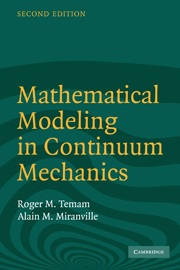Book contents
- Frontmatter
- Contents
- Preface
- A few words about notations
- PART I FUNDAMENTAL CONCEPTS IN CONTINUUM MECHANICS
- PART II PHYSICS OF FLUIDS
- PART III SOLID MECHANICS
- 13 The general equations of linear elasticity
- 14 Classical problems of elastostatics
- 15 Energy theorems, duality, and variational formulations
- 16 Introduction to nonlinear constitutive laws and to homogenization
- 17 Nonlinear elasticity and an application to biomechanics
- PART IV INTRODUCTION TO WAVE PHENOMENA
- Appendix: The partial differential equations of mechanics
- Hints for the exercises
- References
- Index
14 - Classical problems of elastostatics
Published online by Cambridge University Press: 06 July 2010
- Frontmatter
- Contents
- Preface
- A few words about notations
- PART I FUNDAMENTAL CONCEPTS IN CONTINUUM MECHANICS
- PART II PHYSICS OF FLUIDS
- PART III SOLID MECHANICS
- 13 The general equations of linear elasticity
- 14 Classical problems of elastostatics
- 15 Energy theorems, duality, and variational formulations
- 16 Introduction to nonlinear constitutive laws and to homogenization
- 17 Nonlinear elasticity and an application to biomechanics
- PART IV INTRODUCTION TO WAVE PHENOMENA
- Appendix: The partial differential equations of mechanics
- Hints for the exercises
- References
- Index
Summary
Our aim in this chapter is to treat several classical problems of elastostatics. Strictly speaking, elasticity problems such as those described below cannot be solved exactly in general: they can be solved exactly in very particular cases (e.g., special geometry); otherwise, approximate numerical solutions are obtained using computers. However, in the examples treated below, we are going to find approximate solutions giving an idea of the exact solution under some reasonable conditions that will be made precise in each case (by using, in particular, the Saint-Venant principle described in Section 14.7).
For each of the mechanical problems that we will consider, we will find (by guessing) an exact solution for a modified problem related to the one under consideration. By the uniqueness theorem for elastostatics, there is no other solution to the modified problem. Then, the relation between the solutions of the initial and modified problems is made precise using the Saint-Venant principle. We will also interpret the mathematical results from the mechanical point of view, which leads in general, but not always, to conclusions that are consistent with practical intuition.
Longitudinal traction–compression of a cylindrical bar
We consider an elongated cylindrical bar in traction (or in compression). We assume that the axis of the cylinder is parallel to Ox1 (see Figure 14.1).
For the study of the problem, we formulate the following simplifying assumptions that are realistic when the bar is long enough and when we remain far enough from its ends:
The volume forces are negligible;
The external forces on the lateral surface vanish;
[…]
Information
- Type
- Chapter
- Information
- Mathematical Modeling in Continuum Mechanics , pp. 215 - 234Publisher: Cambridge University PressPrint publication year: 2005
